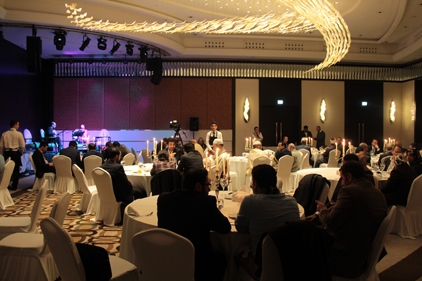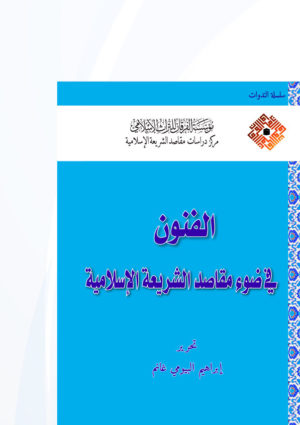The Centre for the Study of the Philosophy of Islamic law at Al-Furqān Islamic Heritage Foundation organised a symposium titled “Arts in light of the Objectives (Maqāṣid) of Islamic Law”, on Saturday and Sunday, 5 - 6 November 2016, at Wyndham Grand Istanbul Europe Hotel.
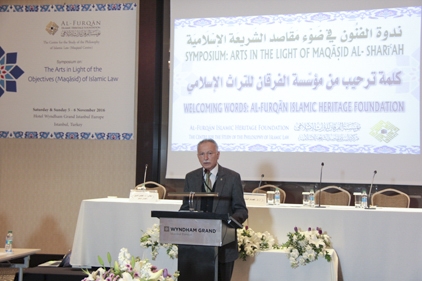
The Symposium opened with a recitation from the Noble Qur’ān, followed by a welcome speech delivered by H.E. Professor Ekmeleddin İhsanoğlu, member of the Board of Directors at Al-Furqān Foundation. Professor İhsanoğlu elucidated the relationship between Islam and the arts, and the influence of other cultures on Islamic arts. He was followed by the speech of Mr Sali Shahsivari, Managing Director of Al-Furqān Foundation who emphasised the importance of the subject of the arts, which had not received its deserved share of scholarship and research, due to its sensitivity. He also explained that the symposium’s significance lay in highlighting the importance of the arts from a Maqāṣid-based perspective. He then stressed the need of working towards promoting and utilising the objectives of Islamic law in the arts sphere, in addition to putting the arts in the service of Islamic law objectives.
Following these opening speeches, Dr Essam Albashir gave a broad and comprehensive speech outlining the symposium. He began by mentioning the need to grant the question of arts due attention, given its importance and consequences, in terms of referral to principal sources (al-ta’ṣīl) or correct application (al-tanzīl), based on an inclusive vision, shying away from individual initiatives in favour of collective intellectual effort. He then articulated some observations relating to scholarly efforts in this domain. Dr Essam Albashir concluded by urging a shift in jurisprudence from recession to revival, in the treatment of the arts, in its Divine basis, moral essence, and human horizon.
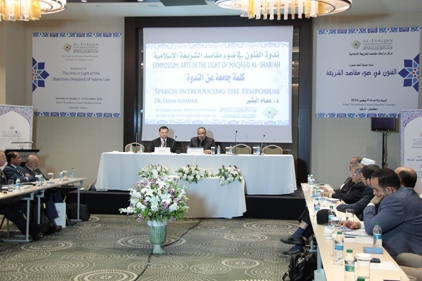
Subsequently, Dr Noureddine Khadimi presided over the first session, beginning with Dr Ahmed al-Raissouni’s paper titled “The arts issue in Maqāṣid-based reasoning through approaches of characterisation (takyīf) and employment (tawẓīf)”. In the paper, Dr al-Raissouni explained the concepts of characterisation (takyīf) and employment (tawẓīf), then presenting and analysing the spectrum of characterisations of the arts, as well as determining their identity; as follows:
the arts considered as: (i) amusement; (ii) crafts and livelihood; (iii) decoration and aesthetic performances; (iv) a form of depravity, hedonism, and sinfulness; (v) means; and (vi) a primordial human need – the last being the least addressed in scholarly work, despite being the most demanded in practice, considering that art is a need embedded in the human soul. After articulating these characterisations, he tackled the employment approaches documented in the past, explaining the diverse aims, including religious, national, social and psychological. Indeed, employment featured as a key element influencing the rulings on art. It follows that inappropriate employment of the arts resulted in rulings of prohibition; this is understood from the statements of erudite religious leaders, like Imām Mālik, Imām Aḥmad, and Imām al-Nawawī.
Dr Mutaz Alkhatib commented on the paper. He began by saying that writings on the arts were active in the late 19th century. However, in the 20th century, the concept of art was granted an elevated value. He then moved on to speak about the arts domain in the present day, considering that art had ceased to be a quest for beauty, and became the pursuit of ideas. From this perspective, Dr Alkhatib called for the necessary awareness of such changes in concepts.
Dr Idham Mohammed Hanash delivered the second presentation of this session, on the topic of “Jurisprudence (fiqh) of beauty: The Maqāṣid of Islamic art from juristic characterisation (al-takyīf) to referral to principle sources of knowledge (al-ta'ṣīl)”. He began by speaking about art as a medium to the discipline of aesthetics. He explained that art was a human practice performed by anybody. He emphasised the need to consider art as an epistemological foundation within the realm of Islamic reasoning. Dr Idham proposed a Maqāṣid-based system composed of Divine objectives, which are: the epistemological essence of the sciences of logic, law, Islamic law, and jurisprudence; ethical objectives, which are: the epistemological essence of the disciplines of ethics, edification, and behaviour; and the aesthetic objectives, which are: the epistemological essence of the discipline of aesthetics and philosophy of art.
The lecturer expanded on the explanation of beauty (al-ḥasan)as an objective, emphasising that it is a natural objective from among those objectives of the primordial human nature and creation, a rite of worship among those devoted to sincere monotheism (al-tawḥīd); a human endeavour among those relating to life, relationship, and urbanisation; and an aesthetic epistemological feature among those features of thought and construction. Hence, he defined the jurisprudence of beauty (al-ḥasan) as the Islamic epistemology of the philosophy of beauty. Moreover, he invited jurists to solicit the assistance of aesthetics experts and scholars in their fatwas.
Dr Essam Talima commented on this paper, pointing to the importance of Prophetic tradition (Sunnah) in establishing the epistemological basis of art, and the relationship of politics to art. He then spoke of the necessity of indicating the backgrounds and rationale of the prohibition of some types of art, in order to understand jurisprudential characterisation (al-takyīf).
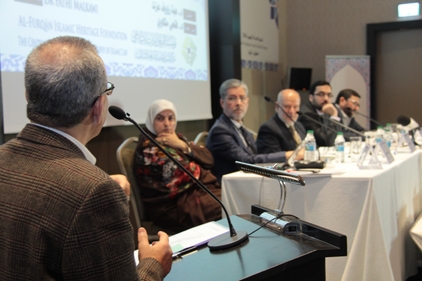
Dr Fathi Hassan Malkawi presided over the second session, which began with the delivery by Mr Ayman Mohammed Adib of the paper, “Saving the primordial human nature (Fiṭrah)... The Maqāṣid sense as a social structure”, co-authored with Dr Mazen Hashem. Mr Adib emphasised the necessity of looking to the Qur’ān as a self-sustaining universe. He stressed the need for abandoning the approach of simplification, characterising the modernist era, away from the logic of simple formulae and dogmatic responses. Furthermore, Mr Adib explained that art is a tool for developing the senses through true engagement, such that it is transformed into a natural trait able to see Islam quite finely from this perspective, a nature that is drawn to beauty at each step, and detests profligacy as much as stagnation. Living with the Noble Qur’ān, living with art, and living with nature, are all interdependent elements that help the human being defend the remnants of the primordial human nature in himself, and to develop them in face of a materialist trend driving it to the abyss.
Mr Wanis al-Mabrook commented upon the paper, commending its depth and novelty, yet criticising the concept of “structure”, as proposed in the paper. He recommended linking these issues to some of the thorny issues of the past, regarding rational judgement of beauty and ugliness.
The second presentation of this session was on the topic of “The universal language of Islamic art” by Dr Minwer Thamir Elmeheid in which he highlighted the link of Islamic art to divine geometry based on the golden proportions. He indicated its manifestations in the phenomena of the universe and nature that were wisely created by God, as carriers of meaning, and signs evidencing God’s Majesty and awesome power.
In his presentation, Dr Minwer alluded to the fact that in all civilisations the most perfect shape is the circle, because it is based on the matter of the centre and radiating to its surroundings. He explained that the circle appears in existence in different sizes and dimensions, both infinitely minute as well as infinitely large in breadth and depth.
Dr Heba Raouf Ezzat commented on this presentation, focusing on the higher foundations and concepts on which the paper was based, most prominently, the concept of primordial human nature, its manifestations and representations, as well as the concept of testimony (shahādah), creation, orbit, balance, and distribution.
Dr Heba dwelt on the concept of expansion and its association with the universe, asking whether the universe was indeed expanding. She also posed the question on the relationship of the geometric proportions with the science of inheritance. Dr Heba also pondered over some examples that clarify the relationship between art and geometric proportions in architecture, represented by the Noble Ka‘bah.
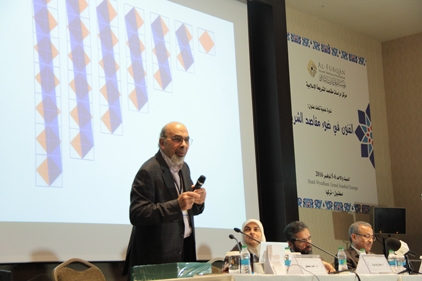
Dr Heba Raouf Ezzat presided over the third of the Symposium’s sessions, which began with a presentation by Dr Ahmed Moustafa titled “The objectives of Islamic law (Sharī‘ah) and geometry of letters as receptacles of Divine immanence”. Dr Ahmed dwelt on the science of calligraphy, emphasising that this is the primary art of Islam. He evidenced this in that Islam’s Book to all mankind was in Arabic. Furthermore, he clarified the importance of geometric laws, considering these as Divine.
Dr Ahmed clarified the development of calligraphy, and praised the role of Ibn Muqlah in developing and refining this discipline. He also studied the letters, stopping at the letter alif, and its relationship with the geometric dot.
This was followed by a presentation by Dr Recep Şentürk, titled “The spirit of religious architecture: The example of Suleymaniye Mosque”. He clarified that the art of Islamic architecture contains all aspects of existence as well as metaphysical symbols, as embodied in the architectural heritage and combining beauty and symbolism.
From this viewpoint, the architectural historical object has a symbolic and internalised existence, underlying the image witnessed by the naked eye and symbolic language bearing different meanings.
Dr Şentürk studied the example of the Suleymaniye Mosque to review these aesthetic meanings and the reflection of Sufi symbols on the architectural elements of Ottoman mosques. This was based on the writings of the architect - Mimar Sinan - of the Suleymaniye Mosque, through which he arrived at the Ottoman architectural philosophy with its origin in pure Islamic Sufism. This brings this architectural form into a harmonious relationship with the heritage of the past, while seeking to integrate and complement the present.
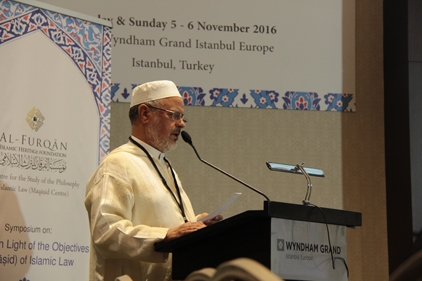
Dr Ibrahim Elbayomi Ghanem commented upon this paper. He commended its high level and depth, and pondered over the state of architecture today, and why such artistic greatness had waned. He also reflected upon the philosophy of Mimar Sinan.
On the second day of the Symposium, Dr Essam Albashir presided over the fourth session. The session’s first paper was titled “Arts and the objectives of Islamic law (Maqāṣid): The arts that serve Maqāṣid, and the Maqāṣid that serve the arts” by Dr Noureddine Khadimi. He began by emphasising that the sphere of Islamic knowledge had not risen to the level of sufficient grasp of the question of the arts, in terms of its wide concept, components, and related elements. Moreover, in the sphere of Islamic activism (Da‘wah), artistic performance had not reached the level to respond to its requirements and challenges. In addition, in the sphere of the Islamic society, the integrated artistic and cultural project had yet to be articulated. Dr al-Khadimi emphasised the necessity of establishing the arts policy of the state, similar to health, development, security, and other policies. He also recommended interest in the issue of the arts as one of the vital and sovereign matters of state.
Following this introduction, Dr al-Khadimi proposed a broad conceptualisation of the arts; one inclusive of values and meanings, as well as the form of their expression, and subsequently the context in which these values and expressions are articulated. He concluded that Islamic arts may be defined as: “values and their expression, through the vision of Islam, to benefit mankind, in context, with beauty and creativity”.
He then moved on to speak about the role of Islamic law texts and objectives in elevating the arts, while dwelling upon the dialectic of the arts and objectives of Islamic law. He concluded that the arts may be classified as improvements (taḥsīniyyah) on one hand, and needs (ḥājiyyah) on the other. He also alluded to the fact that the arts may also be considered as matters of necessity (ḍarūriyyah) in some instances.
This paper was commented upon by Dr Abdelmajid al-Najjar, who explained that enjoying beauty is a need ingrained within the primordial human nature, and indeed, the Qur’ān denounces those who forbid aesthetic enjoyment. Dr al-Najjar pointed to a number of positive aspects within the paper, including the broadening of the concept of art, to include both emotive and moral beauty. He also indicated that the paper had expanded on the matter of the art serving Islamic law objectives, while falling short on the matter of Islamic law objectives serving the arts, in addition to the limited referencing of both Qur’ān and prophetic tradition, as well as the absence of discussion on historical experience to build upon.
The second presentation in the session was titled “The problematic relationship of the fine arts with the objectives (Maqāṣid) of Islamic law” by Dr Ibrahim Albayomi Ghanem. In this paper, Dr Ghanem emphasised that the problematic issue of the arts is complex, with dimensions in application, practice, and behaviour. He emphasised that the arts are an original element within the Islamic vision of life, and that they are neither complementary nor emergent. He proposed the founding of fine arts faculties in the Islamic universities, in order to break the secularism practised by Islamists themselves. He also suggested benefitting from some of the main theories prevailing in the West.
Dr Hasan Jaber commented upon this paper, highlighting points of ambiguity in some areas. Furthermore, he questioned whether there was Islamic art and human art. He postulated that the definition of art is connected to the human spirit. He also explained that Islamic law objectives are linked to values embedded within the human spirit, as these are part of God’s creation of the human being. It is this, in his opinion, that lends weight to the human character of the arts. He concluded by saying that there is a common criterion for aesthetic judgement amongst mankind. Therefore, it is necessary to determine the rules for human art to confront shared challenges.
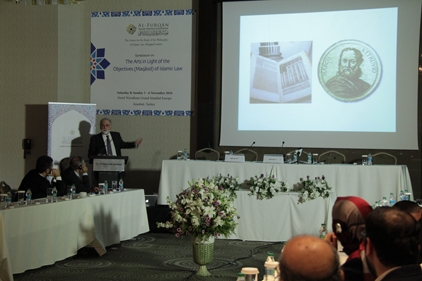
During the fifth session of the symposium, presided over by Dr Recep Şentürk, the paper titled “Modern art and Islam” was delivered by Mr Ahmed Paul Keeler, in which he spoke of the history and development of art. He explained the dominance of the humanist perspective of the world, which came as a substitute for the perspective of the sacred, as was the case in Christianity. He then presented the trend in the development of art, that documented the cruelty, chaos, and brutality that swept the world during the last century, and the elevation of man from the human to the divine space.
In the sixth session presided over by Dr Ahmed al-Raissouni, the paper titled “Manifestations of the objective of monotheism (Tawḥīd) in Islamic art: The theory of Ismā'īl al-Fārūqī” was delivered by Dr Fathi al-Malkawi. In the presentation, he explained the employment of Islamic law objectives, and the instances when it had suffered misunderstanding due to improper employment. He revealed some of the consequences of this matter on the issue of the arts in Islamic thought and Islamic practice.
Dr al-Malkawi presented Ismā'īl al-Fārūqī as an important model of novel juristic effort (ijtihād) on the arts question. Indeed, al-Fārūqī emphasised the role of monotheism (tawḥīd) in framing Islamic art, as part of his project of “reforming Islamic knowledge”. In this respect, Dr al-Malkawi highlighted a number of the aspects of distinction in al-Fārūqī’s treatment of the arts question.
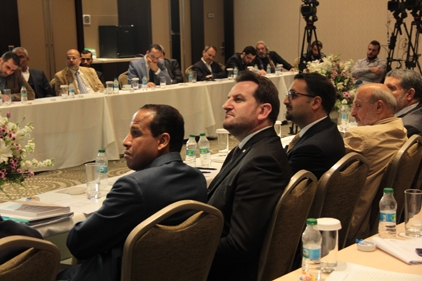
Dr Raed Okasha commented on this presentation by focusing on the idea of frame of reference and its role within al-Fārūqī’s theory related to the art adhering to Islamic practice. In addition, Dr Okasha distinguished between the artistic discourse on art, which is the area of distinction of Lamyā’ al-Fārūqī, and the epistemological discourse on art, as the area of distinction of Ismā'īl al-Fārūqī.
This was followed by the presentation by Dr Wasfy Ashur Abu Zayd titled “Al- Qaraḍāwī's opinions on the arts: An inductive, analytical, Maqāṣid-based reading”. In the paper, Dr Abu Zayd followed up and applied induction to the work of Shaykh Yusuf al-Qaradawi on the issue of the arts within his different writings. He presented some of the artistic works produced by Shaykh al-Qaradawi in the domain of the arts, namely plays and poetry. He then explored a number of issues related to the arts in the writings and literature of Shaykh al-Qaradawi, moving on to analyse his opinions and the extent these are governed by Islamic law objectives in the issue of the arts.
This paper was commented upon by Dr Essam Albashir, who opined that the title did not reflect the content, because the paper addressed the art of Imam al-Qaradawi and his opinions on art. He proposed the following title “The arts in the view of Shaykh al-Qaradawi: vision and application”. Dr Albashir was also critical of the paper, emphasising the predominance of the descriptive, and the absence of analysis and criticism.
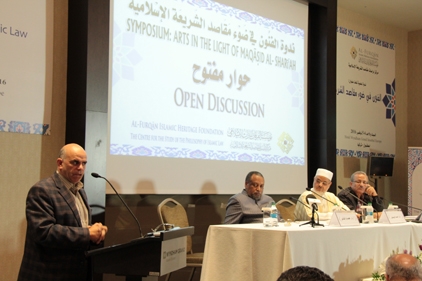
After the symposium presentations were completed, an open session was convened, with a panel comprising: Dr Ahmed al-Raissouni, Dr Essam Albashir, and Dr Ibrahim Albayomi Ghanem, in which the level, subject matter, and current relevance of the symposium was commended. This was followed by a final session, where the concluding speech was given by Mr Sali Shahsivari, Managing Director of Al-Furqān Foundation, and then a speech from the Organising Committee, delivered by Mr Mohamed Drioueche, followed by a reading of the Symposium recommendations.
The recommendations included:
● Convening another symposium on the same topic, so as to secure full treatment of the subject matter.
● Stimulating the means of moving from a jurisprudence based on referral to principal sources (ta’sīl) to a jurisprudence of grasping the initiative and characterisation, using different means, including:
- Launching a website or magazine on Islamic arts in order to encourage research in the art domains.
- Establishing an award for innovation and Islamic arts.
- Contributing to the issue of fatwas based on Maqāṣid criteria to assist arts practitioners.
- Seeking to publish a promotional guide to the different types of known arts and their historical background, and linking this to examples and names of workers in our Islamic heritage — if any.
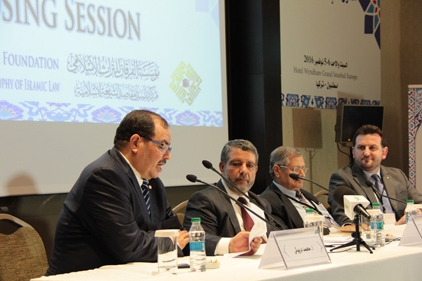
● Calling for future specialist symposia to discuss the most prominent and influential contemporary arts, alongside experts in these.
● Proposing the establishment of fine arts faculties in Islamic universities.
● Establishing study curricula in the arts from the perspective of Islamic law objectives.
● Holding meetings and workshops on the philosophy and objectives of architecture.
● Publishing a simplified promotional booklet on the Maqāṣid, architectural and aesthetic content, for the benefit of architecture and fine arts faculties.
● Launching a project of an encyclopaedia on the jurisprudence of the arts, as a source for a syllabus to be proposed to universities, ministries, and knowledge institutions.
● The addition of a chapter “jurisprudence of the arts” to be taught within the subject of “Islamic jurisprudence” at faculties of Islamic law.
● Forming a diverse team to formulate a strategy in the arts domains from the perspective of Islamic law objectives, including the obligatory referral to original sources, and proposing work plans for promotion and operationalisation.
● Enabling imams, orators, Islamic callers, thought leaders, and others in Europe to benefit from the outcomes of the Symposium.
● Petitioning all regional and international organisations and bodies to protect heritage in general, and arts heritage in particular, in light of the indiscriminate targeting of Arab urban centres.
The Symposium activities ended on Sunday evening, 6 November 2016, with an evening of artistic performances.
All praise is to God through Whose Bounty good works are complete.
